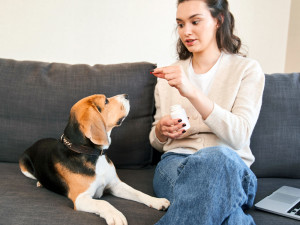Can You Use Hydrogen Peroxide On Dogs?
And the risks you need to know.

share article
In This Article:
Inducing Vomiting with Hydrogen Peroxideopens in a new tab Other Medical Uses for Hydrogen Peroxide for Dogsopens in a new tab When Not to Use Hydrogen Peroxideopens in a new tab Side Effects of Giving Dogs Hydrogen Peroxideopens in a new tab
Hydrogen peroxide, a common household antiseptic, may be recommended by a veterinarian for dog parents to use for inducing vomiting if a dog ingests a toxic substance. However, it’s crucial to understand the potential risks of using hydrogen peroxide on your dog.
Some dogs just love eating stuff. Whether it’s dog food, kitchen snacks, something they find on the ground, or whatever they can reach on a counter, everything gets tastedopens in a new tab and swallowed. They aren’t the best at discerning possibly harmful substances like medications, toxic foodsopens in a new tab, or indigestible objects from edible snacks.
Inducing vomiting with hydrogen peroxide
This type of voracious eating can leave you in a position where you need to make your dog vomit to prevent serious problems. Depending on what was eaten and how far from a veterinarian you are, your vet or a poison-control center for animals may recommend hydrogen peroxide (H2O2) to induce vomiting in dogs that have eaten toxic or foreign material.
Going to your vet’s office or an emergency clinic is generally the better option, because they can use medications that have fewer potential side effects. But sometimes you’re too far from a clinic, or the toxin takes effect quickly enough that trying to induce vomiting at home is recommended.
There are some things to consider before inducing vomiting with hydrogen peroxide. Some factors that affect the use of hydrogen peroxide in dogs include:
What your dog ate: Some toxins are slow to take effectopens in a new tab, so rushing to give peroxide at home may not be necessary. Other toxins can cause problems if vomited up, so inducing vomiting may not be the best plan. Oily substances carry the risk of aspiration (going into the lungs) when vomited up. Sharp objects can cause more damage coming back up than they did going down.
How much your dog ate: Some toxins require a certain amount to be ingested to begin to cause problems. Your veterinarian or a toxicologist can advise you on the chance of injury vs. the risk of problems from inducing vomiting at home. Sometimes waiting and watching is the best approach.
Your dog’s size: The dose of hydrogen peroxide varies based on a dog’s weight and has a maximum, even for very large dogs. Your vet or a poison-control center can guide you on the appropriate dose for your dog so that you don’t cause more problems than you solve.
Pre-existing medical problems: Dogs with previous stomach issues, especially related to gastritis or stomach ulceration may be more prone to developing side effects after receiving hydrogen peroxide. Let your vet clinic know about any previous medical issues before proceeding.
How old your hydrogen peroxide is: H2O2 degrades over time. That old bottle that’s been sitting in the medicine cabinet for years may not be effective anymore. A fresh bottle of hydrogen peroxide is best, but it’s not worth running to the store to pick one up — that time would be better spent getting your dog to the vet’s office. You can test a bottle you have at home by pouring some down the sink. If it’s foaming and you can hear fizzing, the bottle is likely reasonably fresh.
What kind of hydrogen peroxide you have: Hydrogen peroxide comes in a variety of concentrations. The three percent solution is used for inducing vomiting. Pet parents who have done hair dying at home may have a six percent solution around. More is not better in this case. A more concentrated solution is more likely to cause harm and is not recommended for oral use.
What if you gave your dog hydrogen peroxide, and they didn’t vomit? A single re-dosing may be recommended after 10 minutes, but confirm this with your veterinarian before proceeding. Giving more than two doses is never recommended and will increase the chances of unpleasant side effects.
Other medical uses for hydrogen peroxide for dogs
Hydrogen peroxide has been around forever and has been recommended for all sorts of uses over time. In general, H2O2 probably isn’t the best answer for the problem you’re trying to solve for your dog. There are going to be safer and better products available for whatever possible use you can come up with. Some previously suggested uses include:
Cleaning minor wounds
Most people remember scraping their knee as kids and having hydrogen peroxide poured on it after to “clean it up.” It bubbles up dramatically and stings like crazy, so it must be doing something, right? Actually, hydrogen peroxide slows wound healing by damaging cells that help repair the skin and may drive bacteria deeper into woundsopens in a new tab. Don’t bother upsetting your dog by applying H2O2; just rinse minor scrapes well with water or saline and contact your vet.
Whitening tear stains
Hydrogen peroxide can cause some bleaching of tissues and hair, so it has been recommended for lightening tear stains in the past. While it may help a little with this, there are concerns about using H2O2 near dogs’ eyes. There are wipes and other products made specifically for tear staining in breeds predisposed to problems.
Ear cleaning
Hydrogen peroxide can help break up some of the gunky organic material in ears, but again, there are better products for this. Dogs don’t enjoy the sound of bubbling and foaming in their ears and may freak out while trying to get away from it. H2O2 can also cause big problems if an ear problem has damaged the eardrum. It can cause severe irritation and neurological symptoms if it gets past the eardrum into the middle ear canal. Use a veterinary-approved ear cleaneropens in a new tab that is balanced for a dog’s ear pH.
Oral care
In the past, vets sometimes recommended a paste of salt, baking soda, and hydrogen peroxide for dental cleaning. This method has been proven ineffective and potentially harmful. Ingestion of the salt can cause salt toxicity, and the H2O2 is very hard on the gums and other mucous membranes in the mouth. Stick to a VOHC-accepted toothpaste to keep your dog’s teeth cleanopens in a new tab.
It’s not all negative, though. One successful semi-medical use for hydrogen peroxide is as a part of a mixed solution to help reduce the stench on dogs sprayed by skunksopens in a new tab. H2O2 works with dish soap and baking sodaopens in a new tab to help break down some of the odiferous substances in skunk spray. Just avoid smoking near it (it’s flammable), keep it out of your dog’s eyes, and watch out for bleaching of hair, clothes, towels, etc., from the peroxide.
When not to use hydrogen peroxide
Although it’s easy to get caught up in the moment and think you have to do something right away when your dog eats something they shouldn’t, stop and take a breath. Contact your vet or a poison-control center to see what the best course of action is. H2O2 isn’t needed in every situation and can have some possible downsides.
Only give your dog hydrogen peroxide if advised to do so by a veterinarian and only in the amounts recommended.
Side effects of giving dogs hydrogen peroxide
Although hydrogen peroxide can be used to induce vomiting in dogs and has been used in the past as part of other remedies, it does have some downsides. Problems seen with hydrogen peroxide include:
Stomach upset: Obviously, giving hydrogen peroxide to induce vomiting is going to cause some stomach upset. That’s the entire purpose. H2O2 causes vomiting by irritating the lining of the stomach. This is great, but that irritating action has some lasting effects. Dogs given hydrogen peroxide showed inflammation of their stomach lining over a week after administration.
Chemical burns and skin irritation: Concentrated formulations of H2O2 can cause damage to intact skin. Even normal concentrations of hydrogen peroxide can cause whitening of skin and local irritation.
Delayed wound healing and infection: Despite its reputation as a disinfectant, hydrogen peroxide is not recommended for use in wounds for dogs. Using hydrogen peroxide slows healing and damages cells involved in skin repair and prevention of infection.
Can hydrogen peroxide kill a dog?
Giving drugstore hydrogen peroxide to a dog is unlikely to cause death, unless they are overdosed significantly. A dog given about 10 times the recommended dose of hydrogen peroxide to induce vomiting developed serious complications and needed multiple days of intensive care to recover. This is why it’s important to only give them hydrogen peroxide as recommended specifically by your veterinarian and to always talk to your vet first.
A word about cats, because it’s very important. Never give a cat hydrogen peroxide. Cats are much more prone to injury to their esophagus and stomach from peroxide and can develop severe ulcers and bleeding if it is given. There is no safe way to induce vomiting in cats at home, except for putting them on an expensive rug, which they are legally bound to puke on, it seems.
FAQs (People also ask):
Can you clean a dog’s ears with hydrogen peroxide?
Don’t use hydrogen peroxide to clean your dog’s ears at homeopens in a new tab. There are much safer products available that are gentler on dogs’ ears and less likely to worsen irritation.
What should I include in a dog first-aid kit?
The contents of a dog first-aid kitopens in a new tab will vary based on your dog’s expected activity. Some common items include sterile saline, bandage materials, drinking water, a thermometer, and hydrogen peroxide.
How can I get rid of the skunk smell on my dog?
Dogs sprayed by skunks are quite pungent, and getting rid of their new scent can be a challenge. A mixtureopens in a new tab of hydrogen peroxide, dish soap, and baking soda can be used to reduce the skunk odor.
References:

Dr. Bartley Harrison, DVM
Dr. Bartley Harrison, DVM is a small animal veterinarian based in North Carolina who has practiced emergency medicine since graduating from the Texas A&M College of Veterinary Medicine. His primary interest areas include pain management, cardiology, and the treatment of shock.
He is a member of the Veterinary Emergency and Critical Care Society, American Veterinary Medical Association, and American Medical Writers Association. In addition to his clinical work, he writes pet health articles to help provide accurate information for both new and experienced pet parents. When he’s not working, he enjoys cooking, traveling, reading, and going on adventures with his dog.
Related articles
![A mini golden doodle puppy licking and grooming itself.]() opens in a new tab
opens in a new tabHome Remedies For My Dog’s Bleeding Anus
It’s not a pretty problem, but here are your solutions.
![Staffordshire bull terrier dog eating grass]() opens in a new tab
opens in a new tab15 Things You Think Are Toxic for Dogs — But Actually Aren’t
From (human) prescription meds to poinsettia plants, these "toxic" items may not be so bad for your pup.
![Red-haired woman holding sleeping dog in her lap on the bed]() opens in a new tab
opens in a new tab6 Reasons Your Dog Is Vomiting
And how to help them feel better fast.
![black and white dog looking ill laying on couch]() opens in a new tab
opens in a new tabWarning Signs Your Dog Needs to Go to the ER — Stat
Trust me, I’m a vet.
![Black cat with white spots on its fur laying on a light blue blanket while wearing a con around its head]() opens in a new tab
opens in a new tabBe Prepared: Four Pet Emergency Room Essentials for Pet Parents
Lay the groundwork for quick, low-stress treatment.
![A dog getting checked out at the vet]() opens in a new tab
opens in a new tabWhat to Expect At the Emergency Vet
It's every pet parent's nightmare — but knowing what happens when you take your dog to the ER can make the experience a little less stressful.








